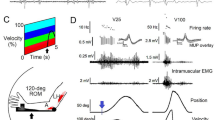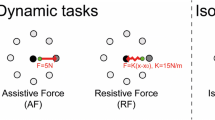Summary
The initial burst of EMG activity associated with arm movements made by normal human subjects was studied. Subjects made visually guided, steptracking movements of different amplitudes and speeds. The duration of the initial agonist burst was greater for large than for small amplitude movements. The burst duration was not continuously graded but was either short (70 ms) for small amplitude movements (less than 20 deg) or long (140 ms) for large amplitude ones (greater than 50 deg). Movements of intermediate amplitudes (30–40 deg) were made with both short and long duration bursts. The increase in the duration of the initial agonist burst for large movements was produced by the appearance of a second component in the burst. Both components were of the same duration and occurred before movement peak velocity was reached. Intramuscular recording showed that both components originate from the same muscle. Similar observations were made in both fast and slow movements and in both the biceps and triceps muscles when they were being used as agonists. The data show that the central nervous system has two mechanisms for generation of large amplitude movements: modulation of the magnitude of the initial agonist burst and generation of a second component or pulse of agonist activity at the start of movement.
Similar content being viewed by others
References
Angel RW (1974) Electromyography during voluntary movements: the two-burst pattern. Electroencephalogr Clin Neurophysiol 36: 493–498
Brown SHC, Cooke JD (1981a) Amplitude- and instruction-dependent modulation of movement-related electromyogram activity in humans. J Physiol (Lond) 316: 97–107
Brown SHC, Cooke JD (1981b) Responses to force perturbations preceding voluntary human arm movements. Brain Res 22: 350–355
Ghez C, Martin JH (1982) The control of rapid limb movement in the cat III Agonist-antagonist coupling. Exp Brain Res 45: 115–125
Hallett M, Marsden CD (1979) Ballistic flexion movements of the human thumb. J Physiol (Lond) 294: 33–50
Hallett M, Shahani BT, Young RR (1975) EMG analysis of stereotyped voluntary movements in man. J Neurol Neurosurg Psychiat 38: 1154–1162
Lestienne F (1979) Effects of inertial load and velocity on the braking process of voluntary limb movements. Exp Brain Res 35: 407–418
Thomas JS, Croft D, Brooks VB (1976) A manipulandum for human motor studies. IEEE Trans Biomed Eng 23: 83–84
Wacholder K, Altenburger H (1926) Beiträge zur Physiologie der willkürlichen Bewegung. X. Einzelbewegungen. Pflügers Arch Ges. Physiol 214: 642–661
Wadman WJ, Denier Van Der Gon JJ, Geuze RH, Mol CR (1979) Control of fast goal-directed arm movements. J Human Mov Stud 5: 3–17
Author information
Authors and Affiliations
Additional information
Supported by the Medical Research Council of Canada (Grant MA6699)
Rights and permissions
About this article
Cite this article
Brown, S.H., Cooke, J.D. Initial agonist burst duration depends on movement amplitude. Exp Brain Res 55, 523–527 (1984). https://doi.org/10.1007/BF00235283
Received:
Issue Date:
DOI: https://doi.org/10.1007/BF00235283




